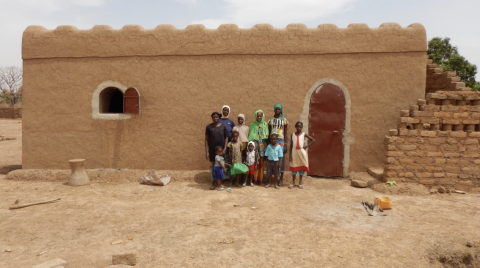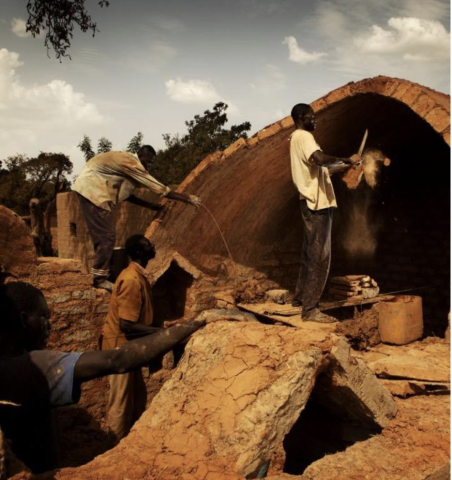West African home owners soon to offer ‘Nubian vault’ climate credits
West African home owners soon to offer ‘Nubian vault’ climate credits
Nubian Vaults, made of mud, stones and water, offer affordable, eco-friendly housing in West Africa. French organisation, Association la Voûte Nubienne (AVN), has built over 7,000 Nubian Vaults and aims to certify carbon credits, incentivising more sustainable housing and positively impacting both the climate and livelihoods in the Sahel. This story is part of a series celebrating the locally-led solutions supported by the UNDP implemented - Adaptation Fund Climate Innovation Accelerator programme.
Mud, stones and water.
That’s just about all it takes to construct green, affordable homes called Nubian Vaults.
As the name suggests, they have famously vaulted, earthen roofs, which work far better than tin roofs to regulate indoor temperatures in West Africa, one of the world’s hottest areas.
In fact, they offer a gain in thermal comfort of an average of +/-7°C compared to sheet metal roofing.

French organisation, Association la Voûte Nubienne (AVN), has enabled the construction of over 7,000 of these climate-friendly houses in Burkina Faso, Mali, Senegal, Mauritania, Ghana and Benin since the year 2000, using the 3000 year-old Nubian Vault traditional technique originating in Upper-Egypt.

Anne-Cécile Ragot, the project lead at AVN, says every one of these arched homes built in the Sahel saves on the carbon emissions usually associated with construction and indoor cooling.
A few years ago, Ragot and her team began wondering if they could use this fact to scale up construction: could the carbon savings from one family’s Nubian Vault fund the construction of another?
They managed to secure support from the UNDP-Adaptation Fund Climate Innovation Accelerator (AFCIA) to answer this question.
AFCIA grants are intended to help accelerate innovative technologies, practices and business models for local adaptation, by tapping into the incredible potential of NGOs, civil society, women and young innovators.
Ragot says they are confident that the carbon credit market will welcome their idea, because AVN’s efforts to grow the market for Nubian Vaults in the Sahel has already proved its worth from both a climate mitigation and an adaptation perspective.
In Senegal for example, Ébou Kankou has lived in a Nubian vault for 10 years. Translated from French, she says, “It’s such a good house. You don’t need timber or zinc roofing sheets to build the house. When it rains it’s not like being under a corrugated iron roof. You only realise it’s been raining when you see the water everywhere; you haven’t heard anything during the night.”
Malick Sy, also from Senegal, says Africans can help combat climate change in their own way, for instance by building Nubian vaults using traditional earth construction methods. “You can’t compare a Nubian vault house with a zinc roofed one just in cost terms; it’s a matter of comparing the quality. I see all the advantages of Nubian vault construction. No longer do we need to cut down trees; the farmers already know about earth construction. Here, all the houses are built in adobe.”
Ragot says it costs EUR400 cash for a family to build their Nubian Vault home, by mobilising materials and unskilled labour sourced locally.
“A family wishing to build a Nubian Vault house contributes about 75% of the cost in kind - they will make the adobe bricks themselves; they will transport the water to the construction site; and they will mobilise some unskilled workers,” says Ragot. “But they need to find 25% in cash to pay the salaries of the mason and his apprentices, and to buy the doors, windows and other external materials.”

But she says even that cost of EUR400 is out of reach for most Sahelian families living with less than two US dollars a day.
Ragot and the AVN team realised that a financial incentive, similar to those in Europe that encourage energy-efficient home renovations, could help solve this challenge for West African families.
The idea was to generate the financial incentive by selling Nubian Vault carbon credits to businesses seeking to reduce their own carbon footprint.
“We did not know much about the carbon market, had never talked to such a business, and did not yet assess what kind of investment was required or how much revenues we could generate,” says Ragot. “In other words, the plan sounded good in theory, but we did not have a clue about how to execute it.”
Using the AFCIA grant, they pitched the idea to potential companies and researched what they would need for the sale of carbon credits to be approved by company boards.
The response, says Ragot, was overwhelmingly positive, as long as AVN manages to secure a carbon credit certification.
“All the organisations we had meetings with were interested, but most of them did not buy our carbon credits because they were not certified by an international standard such as Gold Standard or Vera yet.”
The certification process is complicated, expensive and can take several years, but essentially involves an expert to determine exactly what the carbon-saving potential of one Nubian Vault home is, so that a carbon credit value can be attached to it.
But if AVN completes the certification process, upscaling Nubian Vault home construction in the Sahel over the long-term will be achievable and sustainable, says Ragot.
Le Fonds français pour l'environnement mondial (FFEM) agrees, and has already granted the funds needed to complete the carbon certification, based on AVN’s research and roadmap.
Ragot says a large company has already bought Nubian Vault carbon credits, being confident that AVN will get the certification thanks to the FFEM grant award, and others have assured AVN they will buy credits upon certification.
This is good news for the Sahel, where those families who already live in Nubian Vault homes made possible by AVN say the structures are changing their lives.
“I built my house five times, with a sheet metal roofing, before deciding to construct a Nubian Vault house” said M. Bonkoungou from Burkina Faso.
“There's a big difference between Nubian Vault buildings and tin buildings, in terms of cost, comfort and weather resistance,” they said. “Before, when I came home from the fields in the sun, I didn't have the courage to go into my house because it was too hot. Today, the only place I want to be during the heat is in my Nubian Vault house.”
Ragot says testimony from people like Bonkoungou, Sy and Kankou shows that Nubian Vault housing works, and she says other families in the Sahel area are already queuing to be provided with financial incentive, because they are convinced these homes will improve their living conditions.
About the programme:
This story has been co-created with the support of AVN, UNDP, CDKN, ICCCAD, and GRP, under the framework of the UNDP-managed Adaptation Fund Climate Innovation Accelerator (AFCIA).
The UNDP-AFCIA programme counts on financial contributions from the Adaptation Fund and the European Union and has awarded 44 micro and small grants to locally-led organisations across 33 countries worldwide, accelerating their innovative solutions to build resilience in the most vulnerable communities.
UNDP-AFCIA, is one of the funding windows anchored under the Adaptation Innovation Marketplace (AIM), a multi-stakeholder strategic platform that promotes scaled-up adaptation at the local level, launched by UNDP Administrator Achim Steiner at the Climate Adaptation Summit in January 2021.
